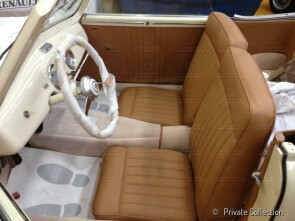
1949 Siata AMICA 49
ON/OFF
Why am I an Automotive Masterpiece?
L. Limited edition cars
no. 50 manufactured
Founded in 1926 by the gentleman driver Giorgio Ambrosini, S.I.A.T.A., an acronym of Società Italiana Applicazioni Tecniche Auto-aviatorie, began its life as a firm specialised in the modification of cars, especially Fiats. In 1937 Ambrosini took over Andrea Mantelli's Carrozzeria Italiana and began to devote himself to the design of small auxiliary engines for bicycles up to the production of cars, rebranding the company into "Società Italiana Auto Trasformazioni Accessori". After World War II and until 1970, the company began making its sports cars under the SIATA brand. The SIATA car emblem is a blue shield, dominated by a golden S cut by the profile of a car. The emblem on the engine head is evocative, formed by an arrow with the diagonal SIATA inscription. The first car branded S.I.A.T.A. was the Amica, a small two-seater cabriolet, produced in two versions. The first one was called “Amica 49” (1948-1949) and presented a tubular perimeter frame built in only 50 units. The second one was named “Amica 50” (1950-1952) with a steel boxed frame built in about 300 units. Both versions were equipped with the mechanics of the Fiat 500 “Topolino” with a “B” type SIATA head and special manifolds. The body of the car was designed by the earl Mario Revelli de Beaumont and built by Bertone, who gave life to a real small GT. The combination of the 633cc SIATA engine with 22 hp and its light weight (about 580 kg) enabled the small car to reach a top speed of 100 km/h. The car’s gear lever was located under the steering wheel, it had top-of-the-range finishes, with strictly selected accessories showcasing the best technical and aesthetic criteria that the specialised industries of the time could produce.
The chassis no. ST 117 identifies one of the few S.I.A.T.A. Amica 49 existing; it is believed indeed that out of 50 cars produced only 14 are still in circulation. The car, built in 1949, was registered for the first time in the public register of Bergamo on May 5, 1950, as reported in the complementary sheet of the time. The car had only two other owners, both from Bergamo; the second one owned it from June 20, 1959, to March 29, 2011. The peculiarity of this car is the futuristic chassis. The car was, indeed, built with a tubular perimeter frame made of special steel tubes, very rigid and non-deformable, replaced from 1950 with a steel boxed chassis to lower the production SIATA’s costs. The chassis no. ST 117, as any Amica 49, has independent front wheel suspension, hydraulic brakes, a 4-speed steering wheel gear lever, and an engine derived from the Fiat 500 with a SIATA cylinder head and special manifolds that led it to deliver 22 hp. The car was completely restored, the colour of the bodywork is ivory with brown leather upholstery, the car still has the original black plate: BG38352.




